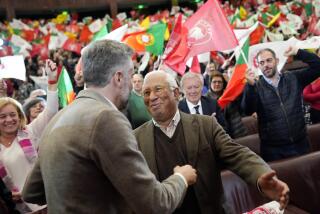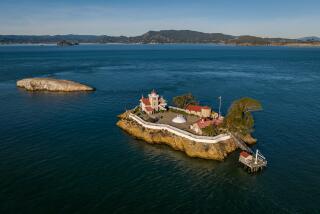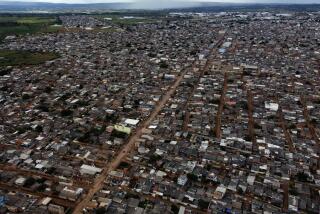It’s Madeira, M’Dear
- Share via
FUNCHAL, Madeira — Here, on an odd, green island off the North African coast, are flowers in riot and rare fruits in profusion. Here is a tiny hardscrabble harbor full of fishing boats in colors so fetching that Winston Churchill, amateur painter and retired British prime minister, once came to work them into his landscapes.
Here is fresh and cheap seafood: tuna caught this morning, filets in banana sauce. Here is the birthplace of a world-famous sweet, red wine. Here are tall, ragged seaside cliffs, raked by smogless gusts, and a green mountain that juts 6,106 feet above the Atlantic. Here are cobblestone streets and narrow, heart-quickening coastal roads navigated by a fleet of spotless, yellow-and-blue Mercedes taxis. And here’s the governor’s big, pink mansion. We’re in Portuguese territory, you see, even though this island lies nearer to Morocco than to Europe. . . .
“My God!” certain British-born readers will be exclaiming right about now. “He’s sending them to Madeira! He’s sending Californians to the Anglo-geriatric capital of the Atlantic! An island without beaches! He’ll be lynched!”
Patience, please.
Madeira is one of Western civilization’s oldest tourist destinations, arguably the first vacation spot the Europeans established outside their own continent. The first settlement there was founded by Portuguese explorer Joa~o Goncalves Zarco in 1420. Before he found his way to the West Indies, Christopher Columbus made it a regular haunt. For several centuries, the island was a required stop for seafaring Portuguese and English imperialists, who relaxed and restocked their ships on the way to and from Africa (just 440 miles east), the Americas and Asia.
With those ships acting as a distribution system, Madeira’s distinctive wine soon became a requisite feature in cellars worldwide. It was drunk by Shakespeare’s Falstaff and invoked in song in the 1950s by Michael Flanders and Donald Swann, the British composers of the playful tune “Madeira, M’Dear.” The island’s wine industry perseveres today, revived after the great grapevine phylloxera crisis in the mid-19th century but marginalized by changing tastes in the global marketplace.
For the last century or so, Madeira has attracted many retired and moneyed British folk who promenade through the fragrant gardens, admire the fruit in the downtown market of Funchal, the main city, and dress for dinner. In the epicenter of this society are the hushed and handsome halls of 101-year-old Reid’s Hotel, where a certain atmosphere prevails and afternoon tea service, with tiny sandwiches and all the trimmings, runs about $20 per person.
For thrills, many of these visitors taxi to a church at Monte, about three miles uphill from Funchal. There, a crew of white-suited men in straw hats awaits. In a ritual drawn from the days when wicker baskets were used to carry materials up and down the island’s slopes, the men help the tourists into rickety wicker sleighs (carros de cesto), then set them hurtling down the steep street. While the tourists laugh and holler, two of the hatted men stand on the back of the sleighs like sled-dog mushers, adjusting the direction with their feet. It’s silly but exhilarating. A 10-minute ride, which covers more than a mile, runs about $10 per person.
*
But there is more to Madeira than tea sandwiches and wicker sleighs. The higher you ascend above sea level, in fact, the more of it you discover. This other Madeira requires sturdy shoes and a robust cardiovascular system. Though the island is just 12 miles wide and 34 miles long, its slopes and valleys are crisscrossed by more than 1,300 miles of levadas, ingenious irrigation ditches that now also serve as trail guides, leading hikers along dizzying cliff tops, along terraced crops and through dozens of tunnels cut into volcanic bedrock. The levada network is one of the few innovations on Madeira not designed with tourism in mind, but thousands of travelers come every year to exploit it.
I arrive in Funchal cranky from a late-night flight and damp from several days of rainy weather on mainland Portugal, and I do not begin as the island’s biggest fan. First, I find that the Santa Isabel Hotel, my home for the next four nights, is a cheap but drab place, and my room faces one of the busiest, noisiest streets on Madeira. (If I had it to do over again, I’d stay part of the time at the Quinta Penha de Franca Albergaria, a more intimate, old-fashioned lodging in the same neighborhood, and part of the time in a higher, more rural part of the island.)
I had been hoping that Funchal would be a sleepy island town, and it just isn’t. Greater Funchal has more than 50,000 residents, with about 200,000 more islanders dwelling nearby, and even though tourists are its bread and butter, it has plenty of other work to do. Though the center of town is outfitted with the expected postcard racks, souvenir shops and sidewalk cafes (and plenty of English speakers), the city looks and sounds a lot like a regional capital, with the traffic to match.
In my cranky mood, I ignore the blooming jacaranda trees along the main drag and the patterned black-and-white cobblestones underfoot. I scoff at the garish waterfront yacht-turned-restaurant that once may have been owned by the Beatles. I decide that Madeira’s cathedral, which dates back to the 15th century, is homely. I dismiss the casino on hotel row, the island’s most prominent piece of modern architecture, as too stark and oppressive. I resolve to visit the Museo da Fotografia Vincentes--a handsome old photographer’s studio known for its collection of images from 19th century Madeira--and it turns out to be closed indefinitely. Some days, certain travelers and certain cities are just not meant to be together.
Surely, I think, things will start looking up. Then I start looking up, at all that greenery and those misty peaks. And in three distinct stages, my life improves.
*
Stage 1: I hire a taxi and we head past fields of bananas, beans, onions, carrots and grapes. The higher we get, the more the fields tilt, until they fall into terraces so implausibly steep that they look like a cruel joke played on the slaves and laborers who cut them in centuries past.
The driver, whose name is Fernando, steers me first to an overlook called Pico dos Barcelos. To the north and west, green terraces climb toward clouds, which cloak the island’s highest peaks. To the south, the fishing boats of Ca^mara de Lobos lie on the rocky beach like abandoned toys, freshly painted in yellows and reds. To the east of the viewpoint lies Funchal, its red-tile roofs climbing the hillsides from the Atlantic. Picture Santa Barbara, with steeper slopes and cliffs instead of beaches.
I could have taken an organized half-day tour on this route--they run about $23 per person--but I decide I’d rather cover the same territory at my own pace for $40. (This is also a common arrangement for hikers who need to be dropped off one place and picked up at another. The island’s main tourist office on Avenida Arriaga in Funchal hands out a list of routes and standard taxi prices.)
Stage 2: Now bound for Eira do Serrado, another viewpoint, we climb the increasingly spectacular R107. A crucial stretch of the road is carved into a stony cliff wall, and if we zig instead of zag, our Mercedes will have a 1,500-foot flight down to the canyon floor. If a big rock should dislodge somewhere above us. . . . Never mind.
“Anything can happen,” Fernando says. “It is better not to stop here.”
Happily, Fernando zigs as required, and I am soon stepping past the hawkers who offer wool caps and wicker work. I follow a path to the prime viewing spot and take up a place at a safety fence built of crooked sticks, nearly 3,600 feet above sea level. This is my Stage 3. Beyond the fence spreads the Curral das Freiras (“shelter of the nuns”) valley: tile-roofed houses that look like red specks and writhing paths carved into the forbidding topography.
The name comes from the 16th century, when Madeirans protected their nuns from French pirates by hiding them in this hard-to-reach valley, which may be the caldera of an extinct volcano. With the help of European Union money, roads have begun to creep into landscapes like this. But even today, some villagers face a two-hour hike before they reach a paved street. Fernando says these villages are full of old women who have spent their entire lives in the valley, never venturing the 10 miles into Funchal.
If I were a committed hiker, I could make this the starting point for a 1.6-mile foray into the canyon, taking a path that gradually descends 1,650 feet to a roadside pickup point on the valley floor. Or, my guidebook says, I could take the more demanding variation, a 3 1/2-hour adventure with a stretch that narrows to about 12 inches wide, with a sheer drop on one side.
Instead, I get back in the cab. On the way down the hill, we stop in the canyon’s main village, which has sprouted a dozen modest snack bars and souvenir shops. Here I sample an island specialty, cake made from the chestnuts that fall from the trees hugging these slopes. It’s moist and tasty. Eyeing the trails, I feel I haven’t properly earned it.
*
The following day, I hire Fernando again and we circle most of the island, periodically pausing for me to hike a little in the high country near Serra de Agua and Rabacal to lunch above the crashing waves and black lava rocks of Porto Moniz. (Most restaurants serving tourists print their menus in four languages, including English. Those menus tend to be built around two dishes: espada, a black, scaleless, eel-like deep-water local fish that is commonly fileted and served with banana-flavored sauce; and espetada, a healthy portion of beef on a skewer, often cooked with laurel leaves and onions.)
Mile by mile, the scenery gets stranger and more wonderful. And the road itself gets steadily more memorable, especially R101 on the north coast of the island, between Porto Moniz and Sa~o Jorge. Here, the spectacle matches anything I’ve ever seen on the California coast, or even Maui’s twisting Hana Highway.
“We call this the washing machine,” says Fernando a little later, grinning suspiciously and slowing the Mercedes. And sure enough, we approach a modest waterfall that splashes down not near the road, but on it. We slowly roll through, our windshield and roof bespattered, sheer cliffs falling away on our left.
In two days, I have traveled from sea level to 5,000 feet and back, and from disdain to something like euphoria.
*
Now, about this geriatric thing.
“Madeira had a reputation, certainly, when we first went there, as a place for geriatrics,” says Pat Underwood, a Londoner who was introduced to the island on her honeymoon in 1973. Underwood and her husband, John, took to hiking the levadas, returning repeatedly, and in 1981 began publishing a guidebook, “Landscapes of Madeira,” that describes driving tours, picnic spots and 41 levada walks.
The book’s “cult” success and the rise of levada-walking, says Underwood, “definitely changed the profile of the kind of people who are going. And that changes more every year. More young people are going.”
Visitors to Madeira these days fall into three major groups: The English; the Germans, whose numbers have doubled in the last five years; and the Portuguese, who seem to have rediscovered the island after decades of largely leaving it to foreigners. Over the last five years, the island has boosted its hotel room inventory by more than 25% (to nearly 18,000).
There are still no real beaches, but visitors who demand them can take a boat or a 15-minute flight to the neighboring resort island of Porto Santo, which is as dry and flat as Madeira is tall and lush.
This doesn’t mean that Americans should cross the Atlantic to behold this place alone. But it may be worth considering for those planning a trip to Portugal or England, or perhaps another European capital, and looking for a second stop to provide a change of pace. The Funchal airport is an 80-minute flight from Lisbon, and travel agencies in England, France and Germany do steady business in filling charter flights to Madeira from London, Paris and Frankfurt.
On about my third island day, I make peace with Funchal, which really isn’t hard. Walking Avenida Arriaga between my hotel and the center of town, I pause to admire caged peacocks and the sculpted garden of the Quinta Vigia (the governor’s house), and the harbor views of the public Parque de Santa Catarina. I take in the sights, smells and sounds of the Mercado dos Lavradores, the island’s foremost market, where strawberries, tomatoes, cherimoya, mango, citrus, cherries, fish and handicrafts are artfully arranged in the courtyard and tiled halls of an airy two-level building.
I even prowl through Reid’s Hotel, purported bastion of all that is fusty, old-fashioned and repressively English in Madeira. Yes, the cheapest double room is about $245, and there’s a tennis shirt for sale in the boutique for $120, and tradition does hang heavy in the air. But the service is alert and unsnobbish, the recently refreshed interior is full of cheerful yellows and blues, and walking through, for an American, is like browsing a museum of class and colonialism. There’s the view balcony, with its black-and-white checkered floor; there’s the lobby library, with its folded copies of the Financial Times; the celebrity cabinet, with its photos of various European royalty, Winston Churchill after World War II and the author George Bernard Shaw taking dancing lessons in 1924. There’s the manicured garden, and there’s the resident bridge master down in the pool, swimming laps while guests curl up with books or snooze poolside in their spotless white terry cloth robes.
*
Several hours later, I settle down to a fine espada dinner on the upstairs terrace of O Tapassol, one in a row of popular restaurants next to Largo do Corpo Santo, Funchal’s oldest quarter. At the next table sits a young Dutch couple, and they tell about their last visit to Madeira, when they took a too-ambitious levada path and ended up marching for 10 hours. Later we head down the street to an agreeably dark and mysterious bar, the Marcelino Pa~o e Vinho, where a series of singers step up to join a guitarist and lose themselves in fado, Portuguese folk music’s answer to American acoustic blues.
The singers are good, full of saudade, the sense of nostalgic melancholy that is supposed to suffuse the Portuguese character. But I keep thinking: Here we sit on this wonderfully odd island, 440 miles off the coast of North Africa. What’s to be melancholy about?
(BEGIN TEXT OF INFOBOX / INFOGRAPHIC)
GUIDEBOOK: Madeira Mix
Getting there: Travelers can take major U.S. airlines from LAX to Newark, Boston or Kennedy/New York, then board a TAP-Air Portugal flight to Lisbon, then change planes again to Funchal, Madeira. On Thursdays and Sundays, TAP-Air Portugal has nonstop flights to Funchal from London. Round-trip fares begin at $1,220.
When to go: Temperatures average 61 degrees in January, 72 in July. The island, which attracts many cruise ships, gets most of its rain in March, April and October. Tourism peaks in April, August.
Where to stay: In Funchal, for luxury and tradition, Reid’s Hotel (tel. [800] 237-1236 or 011-351-91-700-7171, fax 011-351-91-700-7177) has 168 rooms and three restaurants on 10 acres. Rooms for two begin at $245-$290 for most of the year, higher in weeks before and after Christmas and Easter. The Quinta Penha de Franca Albergaria (tel. 011-351-91-229-087), with 40 rooms on its original property and 33 more in a newish waterfront addition, is an intimate place despite megahotels on three sides. A 15-minute walk from central Funchal. Double rooms run $85-$115 from May through October.
On the north coast, consider the 2-year-old Cabanas de San Jorge Village (Sitio da Beira da Quinta, 9240 Arco de San Jorge, Madeira; tel. 011-351-91-576-291, fax 011-351-91-576-032), on a bluff with a Big Sur-type view. Each of the 25 rooms is a round cottage. Doubles about $47, including breakfast.
Where to eat: In Funchal, Restaurante O Tapassol (Rua D. Carlos I No. 62, Zona Velha da Cidade; local telephone 225-023), features seafood and island specialties; dinner entrees $5-$14. A few doors down, Restaurante Sa~o Jose (Largo do Corpo Santo No. 11-13; tel. 223-214); entrees $5-$11. Along hotel row, Quinta Palmeira (Avenida do Infante No. 5; tel. 221-814) has higher prices but a handsome patio setting; entrees $11-$17.
For more information: Portuguese National Tourist Office, 590 Fifth Ave., New York, NY 10036; tel. (800) 767-8842 or (212) 354-4403, fax (212) 764-6137.
--C.R.
More to Read
Sign up for The Wild
We’ll help you find the best places to hike, bike and run, as well as the perfect silent spots for meditation and yoga.
You may occasionally receive promotional content from the Los Angeles Times.







